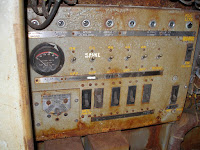Frank writes...
The theme for Sunday seemed to be "straightening." When I got out to the museum the weather was beautiful and there were no urgent projects to work on, so Greg, Thomas and I headed over to Barn 13 and Shaker Heights 18. There we retrieved the car's trolley pole, trolley base, and trolley hook and brought all three back to Barn 4. The pole needed a little bit of straightening to correct some minor bends, so we did that using the patented pole-straightening machine in the barn. Then I wire wheeled and primed the pole and the base. The hook, intriguingly, appears to have all of its past roof colors still on it underneath the final Trolleyville-applied paint, so I'm holding onto that in case we need it for matching roof colors. Unfortunately I failed to take any photos of this work; oops. But here's a picture of the CA&E steel train in service up at the depot.
L-R that's Thomas, Greg, and Richard. Anyway, around this time our friend Tom Schneider stopped by on a visit from the Steam Shop and mentioned that the Steam Team had a gift waiting for us! So of course we excitedly hopped in the golf cart and headed over to Steamland.
Sure enough, the steam guys had managed to repair our bent coupler from the 309 (click here for more information). It's shown above in a press in the steam shop (the tender in the background belongs to Rock Island 4-6-2 938, which is getting a cosmetic restoration). Many thanks to the Steam Team for their work on this! We loaded the coupler onto a cart and made off with our loot. But not before using the brake in the steam shop to un-straighten a new piece of steel for the 18, which needed a 90-degree bend along one side. Once again I forgot to snap a photo but it's this piece.
Recently the coupler from the west end of the 321 was put on the 309, so that means our newly-straightened coupler goes back on the 321. So it was off to Barn 11, with Thomas driving the golf cart and Greg acting as trailer hitch so we could tote along the cart with the coupler on it. It was unloaded next to the car as seen above; a spare 318 coupler shaft with most of the coupler head broken off was also deposited on the end of the car.
And how better to end a beautiful July day than a visit to our newest attraction, Tetanus Railways E33 #4601, now safely stored in the south yards. The view from the roof was better than the view from the ground.



















































